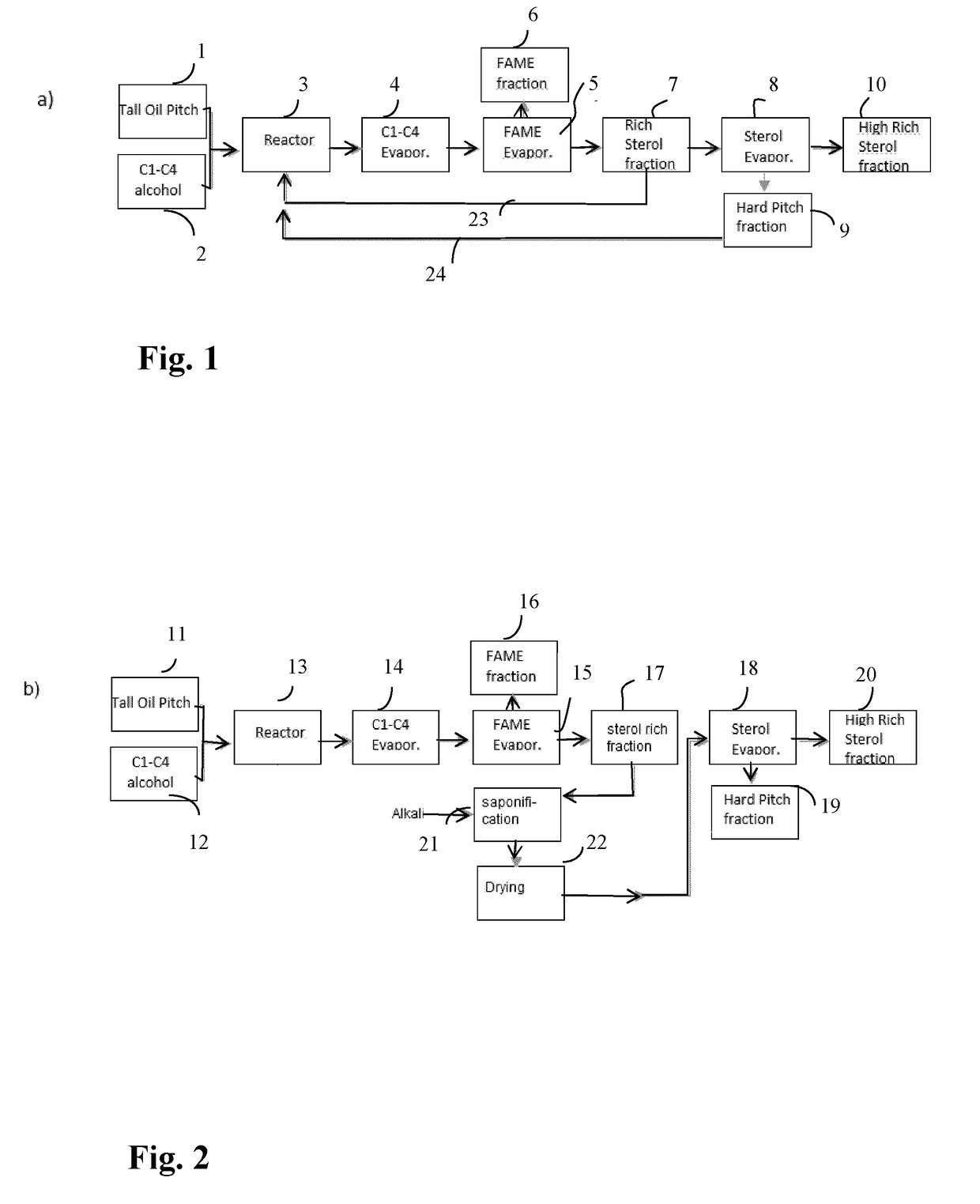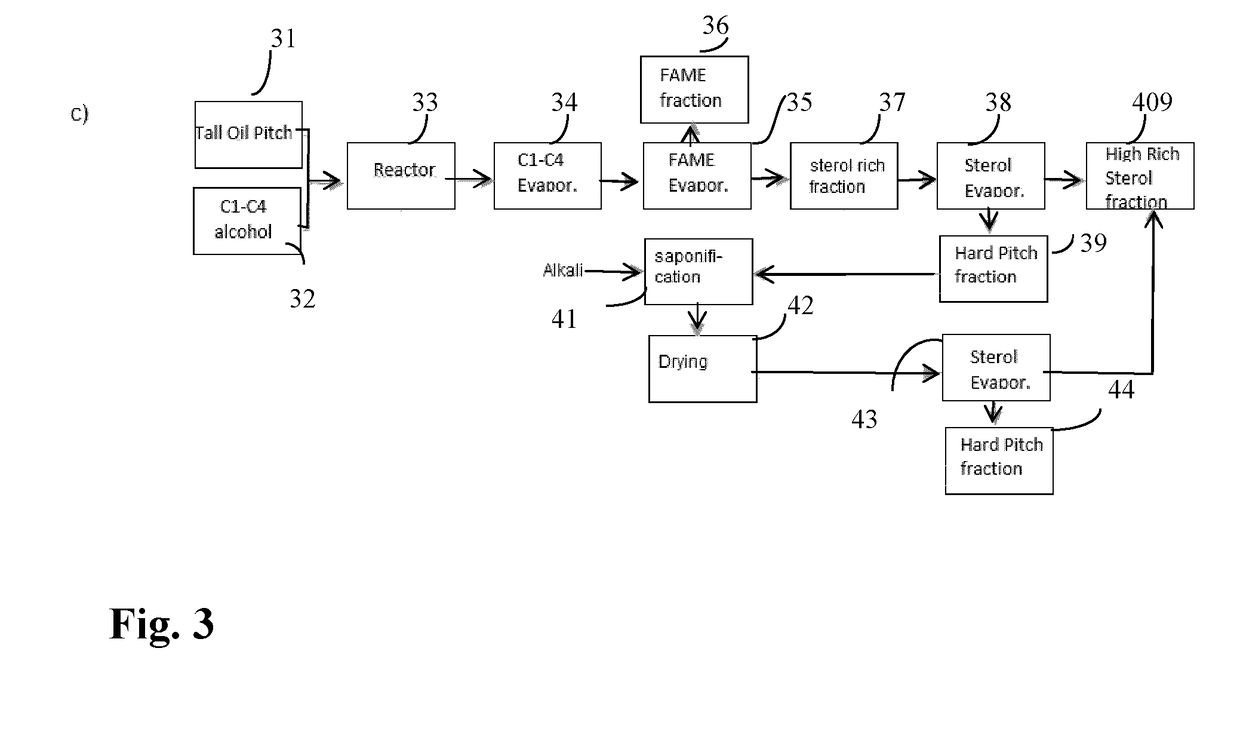Production of sterols
a technology of sterols and sterols, applied in the field of sterol production, can solve the problems of reducing process profitability and sustainability, undesirable processing steps, and relatively complex processes
- Summary
- Abstract
- Description
- Claims
- Application Information
AI Technical Summary
Benefits of technology
Problems solved by technology
Method used
Image
Examples
example 1
[0124]Process for Preparing Free Sterols with Using High or Supercritical Methanolysis without Saponification 722 kg of Tall Oil Pitch (Forchem Oy) and 166 kg of technical grade methanol were heated up to 60° C. and pumped into the tubular reactor with high pressure pump where mixture in rapidly heated up to 280° C. with high pressure of 80 barg. Residence time was 60 min which after reactant was cooled down to 180° C. Excess methanol was partly evaporated by using flash evaporator (GIG Karasek GmbH) and dried entirely with thin film evaporator (GIG Karasek GmbH) at 250° C. under ambient pressure. FAME fraction was recovered by thin film evaporator under 230° C. and 1 mbar, which after high sterol rich fraction and hard pitch fraction was recovered by short path evaporator (GIG Karasek GmbH) at 280° C. (at 0.1 mbar). The products were analyzed by GC.
TABLE 1Tall Evapor-oil atedpitch high after richHard Tall DriedFAMEsterol pitchoilreactantdistillationfractionfractionFree sterols37818...
example 2
[0125]Recycling Hard Pitch
[0126]Hard pitch obtained from Example 1 were recycled by a reaction as follows:
[0127]1033 kg of Tall Oil Pitch (Forchem Oy) and 310 kg of hard pitch fraction and 270 kg of technical grade methanol were heated up to 60° C. and pumped into the tubular reactor with high pressure pump where mixture in rapidly heated up to 280° C. with high pressure of 80 barg. Residence time was 60 min which after reactant was cooled down to 180° C.
[0128]Excess methanol was partly evaporated by using flash evaporator (GIG Karasek GmbH) and entirely dried with thin film evaporator (GIG Karasek GmbH) at 240° C. under ambient pressure. FAME fraction was recovered by thin film evaporator under 230° C. and 1 mbar, which after residual pitch was evaporated by short path evaporator (GIG Karasek GmbH) at 280° C. (at 0.1 mbar). The products were analyzed by GC. The results are given in table 2 and 3.
TABLE 2Tall Hard oilfractionpitch(recycle)Free sterols30.5Steryl esters1615Rosin acids5...
example 3
[0131]Saponification
[0132]Tall oil pitch (Forchem Oy) was processed by methanolysis as described in Example 1. Free methanol and FAME were removed by distillation to obtain intermediate pitch.
[0133]1100 g of intermediate pitch was reacted in closed batch type reactor with 189 g 50-w % KOH in conditions 100→195 deg. Saponified intermediate was cooled and conveyed for drying of excess water into DSL5 thin film evaporator mad by UIC GmbH Germany. Evaporator was equipped with special block wiper peelers. Water was successfully evaporated in conditions 200° C. and 300 mbar vacuum. After drying, intermediate was conveyed to short path evaporator (KDL-5, UIC) where sterol rich fraction was evaporated in conditions 270° C. at a pressure of 0.2 mbar. The products were analyzed by GC and the results are given in table 4.
TABLE 4Inter-mediateEvapor-pitch Sapon-atedTall afterifiedsterol oilDriedFAMEinter-richpitchreactantdistillationmediatefractionFree sterols2.5789.521Steryl esters179500.5Rosin...
PUM
| Property | Measurement | Unit |
|---|---|---|
| temperature | aaaaa | aaaaa |
| temperature | aaaaa | aaaaa |
| temperature | aaaaa | aaaaa |
Abstract
Description
Claims
Application Information
 Login to View More
Login to View More - R&D
- Intellectual Property
- Life Sciences
- Materials
- Tech Scout
- Unparalleled Data Quality
- Higher Quality Content
- 60% Fewer Hallucinations
Browse by: Latest US Patents, China's latest patents, Technical Efficacy Thesaurus, Application Domain, Technology Topic, Popular Technical Reports.
© 2025 PatSnap. All rights reserved.Legal|Privacy policy|Modern Slavery Act Transparency Statement|Sitemap|About US| Contact US: help@patsnap.com


